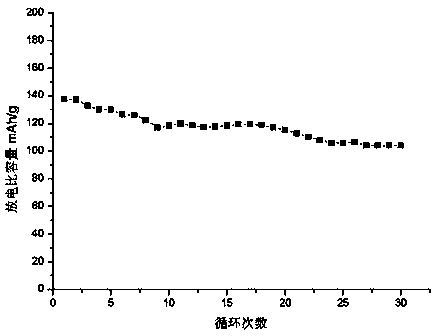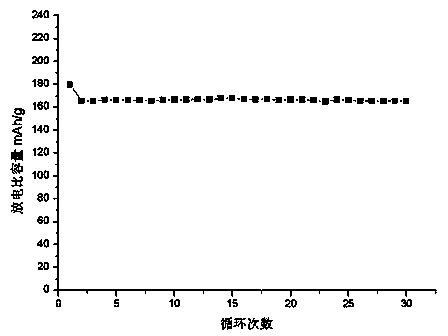Novel lithium ion battery positive electrode material and lithium ion secondary battery using positive electrode material
A technology for secondary batteries and cathode materials, applied in the field of new energy materials, can solve the problems of limiting high current charge and discharge performance, low ion diffusivity, low electronic conductivity, etc., and achieves good application prospects, rich raw material sources, and crystal lattice. Defective effect
- Summary
- Abstract
- Description
- Claims
- Application Information
AI Technical Summary
Problems solved by technology
Method used
Image
Examples
Embodiment 1
[0013] Example 1 NbO, conductive carbon black, and PVDF were mixed in a mass ratio of 80:10:10, coated on the current collector and vacuum-dried at 120°C for 12 hours to make the positive electrode of the lithium battery. A button battery is assembled with a lithium metal sheet as the negative electrode, 1M LiPF6 as the electrolyte, and CELL GARD 2003 as the diaphragm. The electrochemical performance test of the lithium-ion secondary battery made of the NbO positive electrode material was carried out, and the charging and discharging voltage was 1.0V~3.0V. The electrochemical performance of this example product is shown in Table 1.
Embodiment 2
[0014] Example 2 Mix NbO, acetylene black, and polyvinyl alcohol in a mass ratio of 90:5:5, apply it on the current collector and dry it in vacuum at 120°C for 12 hours to make the positive electrode of the lithium battery. Graphite is used as the negative electrode, 1M LiPF6 is used as the electrolyte, and CELL GARD 2003 is used as the separator to assemble a button battery. The electrochemical performance test of the lithium-ion secondary battery made of the NbO positive electrode material was carried out, and the charging and discharging voltage was 1.0V~3.0V. The electrochemical performance of this example product is shown in Table 1.
Embodiment 3
[0015] Example 3 Mix NbO, activated carbon fiber, and polyethylene in a mass ratio of 85:10:5, apply it on the current collector and dry it in vacuum at 120°C for 12 hours to make the positive electrode of lithium battery. A button battery is assembled with carbon-silicon composite material as the negative electrode, 1M LiPF6 as the electrolyte, and CELL GARD 2003 as the diaphragm. The electrochemical performance test of the lithium-ion secondary battery made of the NbO positive electrode material was carried out, and the charging and discharging voltage was 1.0V~3.0V. The electrochemical performance of this example product is shown in Table 1.
PUM
 Login to View More
Login to View More Abstract
Description
Claims
Application Information
 Login to View More
Login to View More - R&D
- Intellectual Property
- Life Sciences
- Materials
- Tech Scout
- Unparalleled Data Quality
- Higher Quality Content
- 60% Fewer Hallucinations
Browse by: Latest US Patents, China's latest patents, Technical Efficacy Thesaurus, Application Domain, Technology Topic, Popular Technical Reports.
© 2025 PatSnap. All rights reserved.Legal|Privacy policy|Modern Slavery Act Transparency Statement|Sitemap|About US| Contact US: help@patsnap.com


